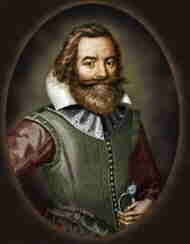 SKC Films Library |
| SKC Films Library >> Virginia >> History |
| Captain John Smith leader of Jamestown Colony
John Smith was born in Willoughby, England, in January of 1580. After receiving his basic education he was apprenticed to a merchant, but at the age of 16 he left that profession in favor of a life of adventure and went to The Netherlands to help the Dutch fight for independence from Spain. Two years later, he was working aboard a merchant ship in the Mediterranean Sea. In 1600 he joined Austrian forces to fight the Turks in Hungary, during which time he was promoted to Captain. He was fighting in Transylvania in 1602 when he was wounded in battle, captured, and sold as a slave to a Turk. He later managed to escape. After being released from service and receiving a large reward, he traveled all through Europe and Northern Africa before returning to England in the winter of 1604-1605. Smith didn't stay in England long, however. Soon after his return he became actively involved with plans to colonize Virginia for profit by the Virginia Company, which had been granted a charter from King James I. The expedition set sail from England on December 20, 1606, and reached what is now Virginia in April 1607. Halfway through the voyage, Smith was accused of concealing an intended mutiny and was almost hung, but he somehow managed to escape death and survived to land at Jamestown with his fellow colonists on May 13, 1607. Despite the accusations made against him during the voyage, Smith was admitted to the ruling council. Largely because of his energy, the colony built up its defenses against hostile Indians and gathered enough corn from trading to survive the first harsh winter. He explored nearby rivers and made a map later used to determine the colony's boundaries. His exploratory trips tooks him at least as far as the Potomac River, near present-day Washington, D.C. According to popular legend, Indians captured him while he was on one of his expeditions, and condemned him to death. But Pocahontas, the daughter of an Indian chief, saved him. Although the story has long been told as true, or at least mostly true, there is actually little evidence to support Smith's account. Although Smith had played a major part in Jamestown surviving its first months, many of the colonists accused him of being too dictatorial. By January, 1608, he found himself once again sentenced to the noose. Only the last-minute arrival of a supply vessel saved his life this time. By September, 1608, Smith had become president of the colony. He forced his people to work to save themselves from another near-disastrous winter. Once again, however, he faced stiff opposition from many of the colonists. He was accused of aiming to make himself a tyrant king, and of terrorizing Indians, bullying colonists, and flogging anyone who opposed him. Although the extent of Smith's abuses were undoubtedly exaggerated to some degree, Smith himself never actually claimed absolute innocence. Having seen Jamestown almost fail in its first winter because many of the colonists refused to do hard labor, he did in fact make it a crime for anyone to not "carry his own weight." And he did indeed make a habit of dealing unfairly with Indians and of making spontaneous attacks on villages which had refused to trade with Jamestown. Smith may very well have been perilously close to being a dictator, but there is little doubt that he played a very important part in Jamestown's ultimate survival as a colony. Nevertheless, word of his supposed excesses eventually made it back to England via a supply ship and the colony's owners dispatched a replacement for Smith. This, combined with a serious injury suffered in a gunpowder accident, forced Smith to return to England in 1609. Once back in London, Smith began actively promoting the further colonization of Virginia, but found very few friends among the Virginia Company owners. His last visit to the New World came in 1614, when he explored and named New England. He was denied further opportunities to return to America due to his independent nature and spent the rest of his life writing books. He died in June of 1631. His writings include: A True Relation (1608) WEB SOURCES SEE ALSO |
| SKC Films Library >> Virginia >> History This page was last updated on June 21, 2018. |
